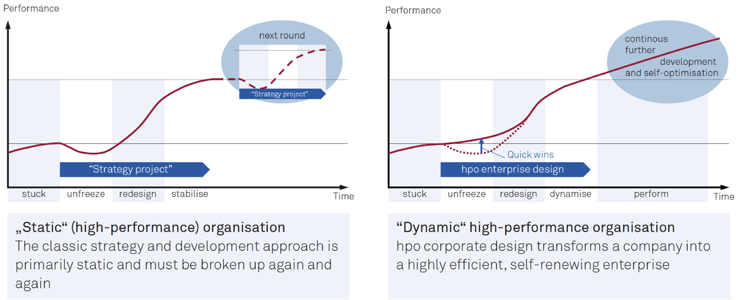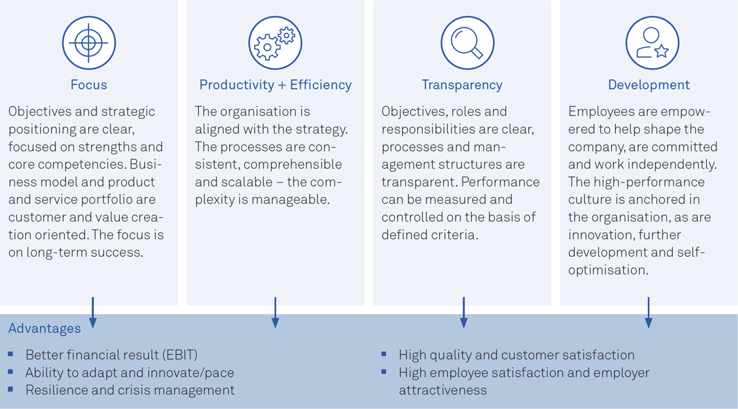What is the secret of agile organisations?
If you stand still, you lose. "Agility" is traded in the business world as an imperative for sustainable success in a dynamic and uncertain world, but has basically always been the natural survival principle of organisations. A high degree of corporate agility ensures adaptability and provides competitive advantages, especially in difficult times. Agile companies are therefore successful companies.
Share article

The key to agility lies in the core
Often, the performance limits of a company only become apparent in critical situations such as the current combination of inflation, raw material shortages and supply chain problems. Whether changes or a new direction can be initiated and implemented quickly depends to a large extent on the complexity of the operational processes. Often, strategic initiatives fail because the organisation is too complex and therefore static (Fig. 1).

Fig. 1: Static vs. dynamic high performance organisation
Typical characteristics of static organisations are grown structures with a high coordination effort, silo thinking or unclear cooperation at the interfaces, complicated decision-making paths, fragmented process landscapes and intransparent workflows. Superficial measures, from agile working methods such as Design Thinking or Scrum to New Work concepts, but also classic Lean programmes fall short here. The key to more speed and agility lies at the core of the organisation.
Agile companies are high performance organisations
High performance companies are the epitome of the agile organisation. They are more efficient (higher EBIT), have more satisfied customers and employees, react faster in crisis situations and are generally more successful in the market. Their ability to adapt and innovate is structurally and culturally embedded, processes are consistently aligned with strategy and complexity is greatly reduced (Fig. 2).

Fig. 2: Characteristics and advantages of the High Performance Organisation
The most important success factors of the High Performance Organisation and prerequisite for more agility and sustainable performance increases are summarised:
- clear strategic positioning and focus on value-adding services
- Consistent, process-based business model and organisation linked to strategy
- Empowerment for control and self-responsibility
Does your company show characteristics of static organisations? Does the complexity in the company slow down the successful implementation of strategic initiatives? Or does the competition react faster to market changes?
For decades, hpo has specialised in the design and operationalisation of dynamic high performance organisations. With our holistic, process-oriented approach to organisational design, we identify the potential of your organisation or a sub-area based on the criteria for high performance and release it step by step together with decision-makers and employees - until the solution is implemented with measurable results.

Your strategy and organisation consultancy
Who is hpo management consulting?
hpo stands for High Performance Organisations. As experts for strategy, business processes, organisation and transformation, we have been supporting nationally and globally active clients since 1995 in releasing performance potential and transforming strategies into measurable results. With our holistic and partnership-based enterprise desing approach, we reliably lead them to their goal: a consistently designed and sustainably effective High Performance Organisation - fit for the future and with a clear competitive advantage.
hpo - unlocking performance